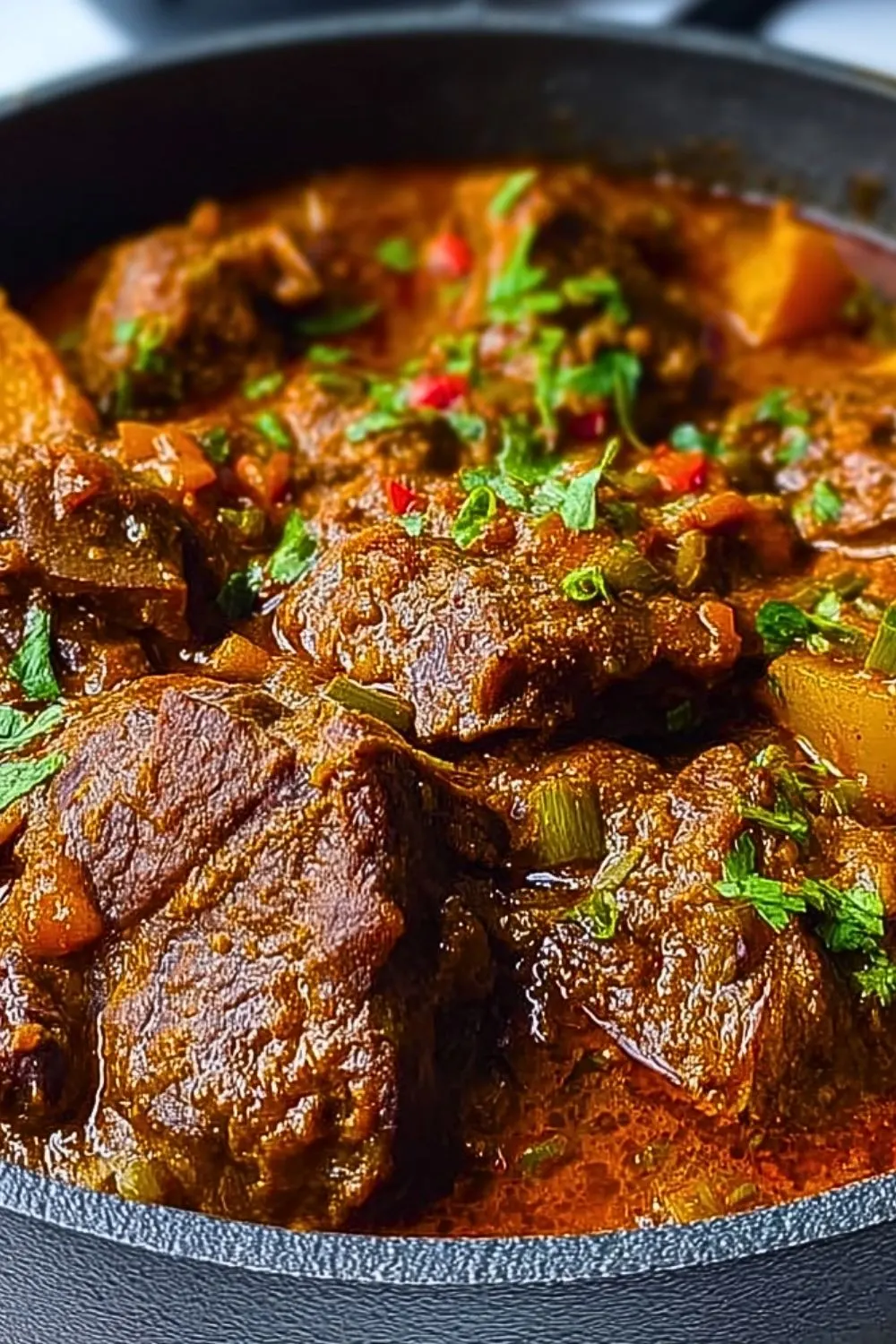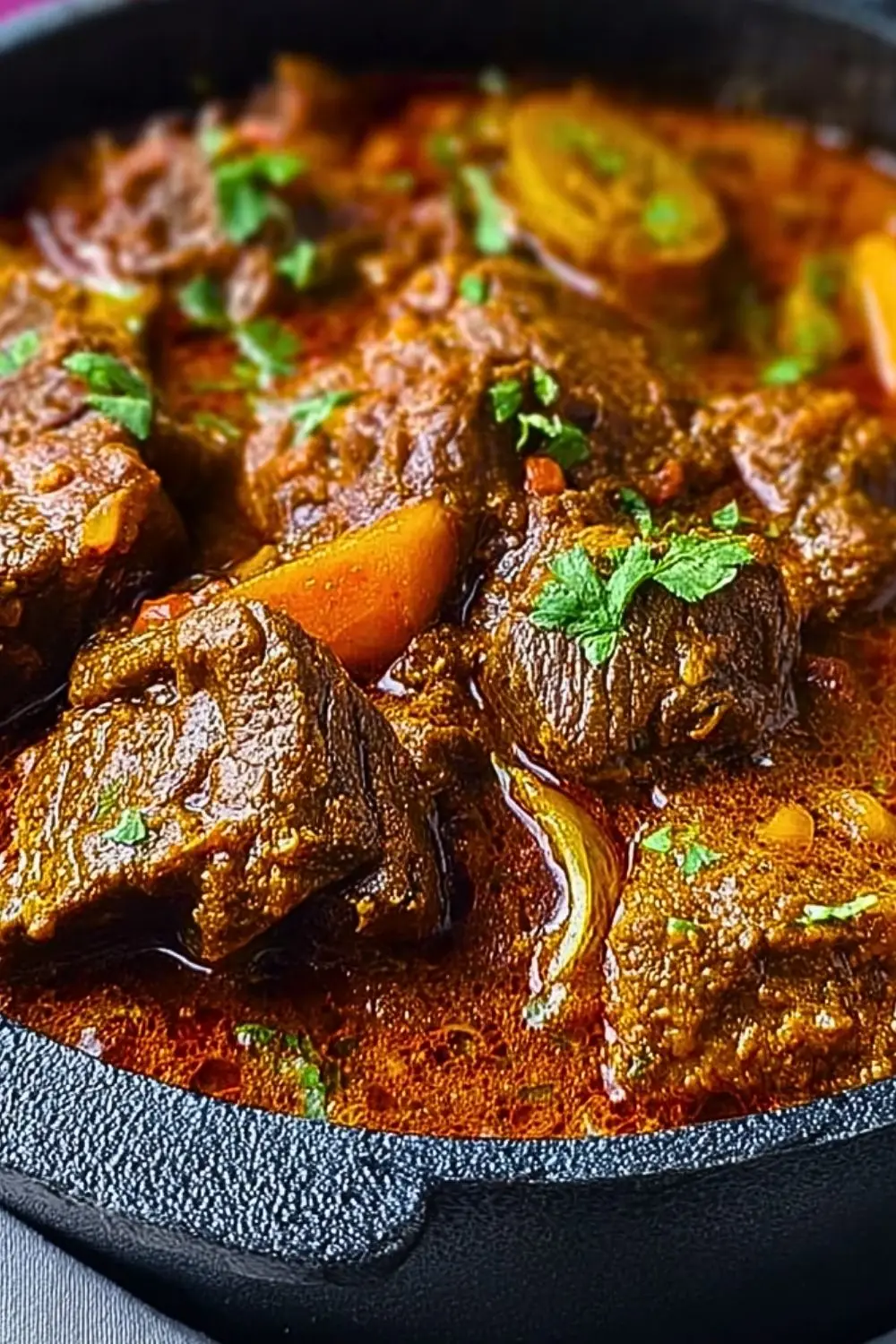Deeply comforting, rich in tradition, and bursting with bold flavors, Nigerian Beef Stew is one of West Africa’s most iconic dishes. Made with tender cuts of beef simmered in a vibrant tomato and pepper sauce, it's a stew that brings warmth to your kitchen and satisfaction to your plate. The aroma alone—filled with notes of garlic, ginger, and Scotch bonnet peppers—is enough to gather people around the table before the first spoonful is served.

This stew isn't just about heat—though it brings a satisfying kick—it's about depth. The long, slow simmering process allows the beef to soak up every ounce of flavor from the seasoned broth, transforming it into something deeply savory and unforgettable. Whether ladled over rice, paired with fried plantains, or served alongside yam or eba, this is comfort food in its purest form.
Why You’ll Love This Nigerian Beef Stew
- Authentic Flavor: Crafted with traditional Nigerian ingredients, this stew delivers the full depth of flavor you’d find in a home-cooked Lagos kitchen.
- Versatile Pairing: Goes perfectly with rice, boiled yam, plantains, or even bread. It's a multipurpose star.
- Make-Ahead Friendly: Tastes even better the next day, making it perfect for meal prep.
- One-Pot Wonder: Minimal mess, maximum flavor. All done in one pot for easy cleanup.
- Customizable Heat: Control the spice to suit your palate—mild, medium, or fiery.
- Satisfying and Hearty: Packed with protein and slow-cooked until meltingly tender.
Preparation Phase & Tools to Use (Essential Tools and the Importance of Each)
Making Nigerian Beef Stew is a rewarding process, but having the right tools makes all the difference in achieving that authentic, deeply simmered taste.
Essential Tools & Equipment
- Heavy-Bottomed Pot or Dutch Oven: This is crucial for slow simmering and browning the beef without burning. It holds heat evenly and locks in moisture.
- Blender or Food Processor: Used to create the smooth tomato, pepper, and onion base—an essential step for the stew’s signature texture and flavor.
- Sharp Chef’s Knife: For cubing the beef and chopping aromatics like garlic, ginger, and onions with precision.
- Cutting Board: Keeps your prep organized and helps avoid cross-contamination between raw meat and vegetables.
- Wooden Spoon or Cooking Spatula: Ideal for stirring the stew gently without scratching the pot or breaking apart the tender beef chunks.
- Measuring Spoons & Cups: Ensures accurate seasoning, especially with spices and seasoning cubes.
- Bowl for Marinating: Helps infuse the beef with layered flavor before cooking begins.
- Lid for the Pot: Essential for trapping heat and steam during the slow simmering process.
These tools help ensure the cooking process is smooth, efficient, and flavorful from start to finish.
Preparation Tips
- Marinate the Beef: Even a quick 30-minute marinade with seasoning cubes, salt, and garlic can transform the meat’s flavor.
- Blend Smoothly: Make sure your tomato and pepper mixture is blended to a velvety consistency to avoid a grainy sauce.
- Parboil the Tomatoes (Optional): Simmering or lightly frying the tomato blend before combining it with the stew can reduce acidity and enhance sweetness.
- Don’t Overcrowd When Browning Beef: Sear in batches to get a deep brown crust, which adds richness to the final stew.
- Skim the Oil: If your stew produces too much oil after cooking, you can skim it off the top for a lighter version without sacrificing flavor.
- Let It Simmer Slowly: The longer the stew simmers, the richer the flavor—resist rushing the process.
- Adjust Spice to Taste: Use Scotch bonnet peppers with caution. You can always add more heat later, but you can’t take it out once it's in.
Ingredients for this Nigerian Beef Stew
To create the rich, spicy depth that defines Nigerian Beef Stew, you’ll need a balance of savory aromatics, heat, and tender meat. Here's the complete list of ingredients to get you started:
For the Beef & Base
- 2 lbs beef (bone-in or boneless chunks) – preferably a mix of cuts like shank, chuck, or brisket for maximum flavor
- 2 seasoning cubes (Maggi or Knorr) – a staple in Nigerian cooking for a bold umami boost
- Salt to taste
- 1 teaspoon garlic powder
- 1 teaspoon ginger powder or freshly grated ginger
- ½ teaspoon black pepper
For the Pepper-Tomato Blend
- 4 medium Roma tomatoes
- 2 red bell peppers
- 1–2 Scotch bonnet peppers (ata rodo) – adjust to taste
- 1 large red onion
- 3 cloves garlic
- 1-inch piece of fresh ginger
For Cooking the Stew
- ½ cup vegetable oil or palm oil – enough to fry the tomato base and stew
- 1 small onion (sliced) – for added sweetness and texture
- 2 tablespoons tomato paste – intensifies the tomato flavor
- 1 teaspoon thyme (dried or fresh)
- 1 teaspoon curry powder
- 1 bay leaf (optional but aromatic)
- Salt and more seasoning cubes to taste

Step-by-Step Instructions for Nigerian Beef Stew
Bringing the rich, bold flavors of Nigerian Beef Stew to life is all about layering and slow cooking. Follow these steps for a deeply satisfying result:
Step 1: Marinate and Boil the Beef
- Rinse and cut beef into chunks.
- Season with salt, seasoning cubes, garlic powder, ginger powder, and black pepper.
- Mix thoroughly and let it marinate for at least 30 minutes (or overnight in the fridge for deeper flavor).
- Add a little water and boil on medium heat until the beef is tender and the stock is rich. Set beef and stock aside.
Step 2: Blend the Pepper Base
- In a blender, combine the tomatoes, red bell peppers, Scotch bonnet(s), large red onion, garlic, and ginger.
- Blend until smooth and set aside.
- Optional: pour the mixture into a saucepan and simmer for 10–15 minutes to reduce moisture and acidity.
Step 3: Brown the Beef
- In a large heavy-bottomed pot, heat vegetable oil over medium heat.
- Fry the cooked beef in batches until browned on all sides. Remove and set aside.
Step 4: Fry the Stew Base
- In the same oil (add more if needed), sauté sliced onions until fragrant.
- Stir in tomato paste and fry for 3–5 minutes.
- Pour in the blended pepper mix and fry on medium-low heat for 15–20 minutes, stirring frequently until the oil begins to separate from the sauce and the raw tomato smell disappears.
Step 5: Combine and Simmer
- Return the browned beef to the pot, along with some or all of the reserved beef stock.
- Add thyme, curry powder, bay leaf (if using), and adjust seasoning with more salt and seasoning cubes if needed.
- Stir well, cover, and let simmer on low heat for 20–30 minutes to allow flavors to marry and the beef to soak up the sauce.
Step 6: Final Touch
- Stir occasionally, taste, and adjust seasoning.
- Skim off excess oil if necessary, or save it for jollof rice.
- Garnish with fresh chopped parsley or green onions if desired.
Notes
- Make It Ahead: Nigerian Beef Stew actually tastes better the next day as the flavors continue to deepen. It’s a perfect make-ahead dish for busy weeks or gatherings.
- Choose Bone-In for More Flavor: Using bone-in cuts like beef shank or ribs will add richness and depth to the stew that boneless cuts simply can’t match.
- Adjust Consistency: If your stew is too thick, you can add a splash of beef stock or water. If too thin, simmer uncovered to reduce and thicken naturally.
Watch Out for These Mistakes While Cooking
- Skipping the Frying Step: Frying the blended tomato-pepper mixture is essential. Raw stew tastes sharp and unbalanced—take the time to fry it properly until the oil separates.
- Overcrowding the Pot When Browning Beef: If you try to brown too many beef pieces at once, you’ll steam them instead. Work in batches for a golden crust.
- Underseasoning the Beef: The first layer of flavor begins with seasoning the meat before boiling. Don’t rely solely on the stew base to season everything.
- Adding All the Stock at Once: Start with a small amount and add more as needed. Too much liquid can dilute the flavor.
- Using Too Much Oil: While Nigerian stews traditionally use more oil, it’s okay to use less or skim the excess once the stew is cooked.
- Overblending the Pepper Base: A too-smooth blend can make the stew feel flat. Leave a little texture for a heartier consistency.
- Ignoring the Simmer Time: This stew needs time to develop flavor. A rushed stew will taste incomplete.
- Forgetting to Stir: Tomato-based stews can burn quickly if left unattended. Stir frequently, especially during the frying phase.
What to Serve With Nigerian Beef Stew?
Nigerian Beef Stew is incredibly versatile and can be paired with a wide range of classic and modern sides. Whether you're craving something hearty, light, or starchy, this stew adapts beautifully.
8 Recommendations
1. White Rice
A traditional and beloved pairing. Steamed plain rice allows the bold flavors of the stew to shine without interference. It’s simple, comforting, and always a crowd-pleaser.
2. Fried Plantains (Dodo)
The natural sweetness of ripe plantains balances out the spicy and savory stew beautifully. Fry until golden and enjoy the contrast in textures and flavor.
3. Yam (Boiled or Fried)
Soft-boiled yam chunks or crispy fried yam sticks both soak up the stew's richness and add a starchy base that’s deeply satisfying.
4. Eba (Garri)
Made from cassava, eba is a staple swallow in Nigerian homes. Scoop it with your hands and use it to mop up every drop of stew—authentic and traditional.
5. Pounded Yam
Smooth, stretchy, and slightly chewy, pounded yam is a wonderful match for the thick consistency of this beef stew. It's ideal for hearty appetites.
6. Jollof Rice
Take your plate to another level by serving this stew over Jollof rice. The layered tomato flavors complement each other while the beef adds extra richness.
7. Agege Bread or Soft Rolls
Use fluffy Nigerian bread or any soft roll to scoop and soak up the stew. It's a favorite street-style combo that’s deeply comforting.
8. Couscous or Quinoa
For a lighter or more modern twist, try serving the stew with couscous or quinoa. They absorb the sauce well and make it feel just a bit more contemporary.
Storage Instructions
Proper storage ensures your Nigerian Beef Stew stays fresh, flavorful, and ready for quick meals throughout the week.
Refrigeration
- Let the stew cool completely before storing.
- Transfer to an airtight container and refrigerate.
- It will keep well for up to 5 days in the fridge.
- Reheat on the stovetop over low heat, adding a splash of water or stock if it thickens too much.
Freezing
- This stew freezes beautifully. Portion into freezer-safe containers or resealable bags.
- Label with date and store for up to 3 months.
- To reheat: thaw overnight in the fridge, then warm gently on the stove or microwave.
Reheating Tips
- Stir well while reheating to ensure even temperature and flavor distribution.
- Avoid overheating, which can toughen the beef.
Estimated Nutrition (Per Serving – Approx. 1 Cup Stew)
Please note these are general estimates and can vary depending on ingredients used:
- Calories: 350–400 kcal
- Protein: 28–32g
- Carbohydrates: 6–10g
- Fat: 22–28g
- Saturated Fat: 6g
- Cholesterol: 90mg
- Fiber: 2g
- Sugar: 4g
- Sodium: 800mg (depends on seasoning cubes)
- Category: Main Dish
- Method: Stewing
- Cuisine: Nigerian / West African
Frequently Asked Questions
1. Can I use chicken instead of beef?
Yes! You can substitute beef with chicken (preferably bone-in for flavor). Just adjust cooking time—chicken cooks faster and doesn’t need as much simmering.
2. What’s the best cut of beef for Nigerian stew?
Tougher cuts like beef shank, chuck, or brisket work best. They become tender during long simmering and release flavor-rich juices into the stew.
3. Is it necessary to fry the pepper mix?
Absolutely. Frying the tomato-pepper base is key to reducing acidity and building flavor. Skipping this step can result in a raw, flat-tasting stew.
4. Can I make this stew less spicy?
Of course. Use fewer Scotch bonnet peppers or replace them with milder peppers. You can also deseed the Scotch bonnet for reduced heat.
5. Why is oil floating on top of my stew?
That’s normal in Nigerian stews. It's from frying the pepper base. You can skim off the excess if you prefer a lighter version.
6. How do I prevent the stew from burning?
Cook on low to medium heat and stir frequently—especially after adding the pepper blend. A heavy-bottomed pot helps distribute heat evenly.
7. Can I add vegetables to this stew?
Yes, you can. Carrots, green beans, or bell peppers can be added toward the end of cooking for extra texture and nutrients.
8. Is Nigerian beef stew gluten-free?
It usually is, especially when made from scratch. Just ensure your seasoning cubes or any prepackaged ingredients don’t contain hidden gluten.
Conclusion
Nigerian Beef Stew isn’t just a meal—it’s an experience that brings bold flavor, comforting texture, and rich cultural history into every bite. From the spicy kick of Scotch bonnet to the deeply savory layers from slow-cooked beef and tomatoes, this dish is a celebration of West African cuisine at its finest.
Whether you're enjoying it over rice, dipping into it with Agege bread, or pairing it with fried plantains, Nigerian Beef Stew delivers every time. It’s perfect for family dinners, meal prep, or festive occasions—and once you master the basics, you’ll find yourself making it again and again.

Nigerian Beef Stew Rich, Spicy & Flavorful
- Prep Time: 20 minutes
- Cook Time: 60 minutes
- Total Time: 80 minutes
- Yield: 6 servings 1x
- Category: Main Dish
- Method: Stewing
- Cuisine: Nigerian
Description
If you're craving bold, warming, and deeply flavorful food ideas, look no further than this Nigerian Beef Stew. This easy recipe brings together juicy beef chunks, blended tomatoes and peppers, and rich spices for a comforting African classic. Perfect for quick dinner ideas, meal prep, or hearty family meals. Whether you’re new to Nigerian food or revisiting a beloved favorite, this dish is an irresistible must-try—especially when paired with rice, plantains, or bread. It's the perfect blend of tradition, spice, and comfort. A great addition to your collection of easy dinner recipes, healthy-ish comfort food, and cultural kitchen adventures.
Ingredients
2 lbs beef
2 seasoning cubes
Salt to taste
1 teaspoon garlic powder
1 teaspoon ginger powder
½ teaspoon black pepper
4 medium Roma tomatoes
2 red bell peppers
2 Scotch bonnet peppers
1 large red onion
3 cloves garlic
1 inch piece fresh ginger
½ cup vegetable oil
1 small onion sliced
2 tablespoons tomato paste
1 teaspoon thyme
1 teaspoon curry powder
1 bay leaf
Instructions
1. Rinse and cut beef into chunks. Season with salt, seasoning cubes, garlic powder, ginger powder, and black pepper. Marinate for at least 30 minutes.
2. Boil the beef on medium heat with a little water until tender. Set aside beef and stock.
3. Blend tomatoes, bell peppers, Scotch bonnets, large onion, garlic, and ginger until smooth.
4. Optionally simmer the pepper mix in a saucepan to reduce acidity.
5. Heat oil in a large pot. Fry boiled beef until browned. Set aside.
6. In the same pot, sauté sliced onions, then stir in tomato paste. Fry for 3–5 minutes.
7. Pour in blended pepper mix and fry for 15–20 minutes, stirring often, until oil separates.
8. Return beef and some stock to the pot. Add thyme, curry, bay leaf, and adjust seasoning.
9. Simmer on low heat for 20–30 minutes. Stir occasionally.
10. Taste and adjust seasoning. Skim excess oil if needed. Serve hot.
Notes
Use bone-in beef cuts like shank or brisket for deeper flavor.
Frying the pepper mix until the oil separates is essential—don’t skip it.
Stew tastes even better the next day—perfect for meal prep or leftovers.
Nutrition
- Serving Size: 1 cup
- Calories: 380
- Sugar: 4g
- Sodium: 800mg
- Fat: 26g
- Saturated Fat: 6g
- Unsaturated Fat: 17g
- Trans Fat: 0g
- Carbohydrates: 9g
- Fiber: 2g
- Protein: 30g
- Cholesterol: 90mg
Keywords: Nigerian beef stew, African recipes, spicy tomato stew, easy dinner, beef recipes, pepper stew

